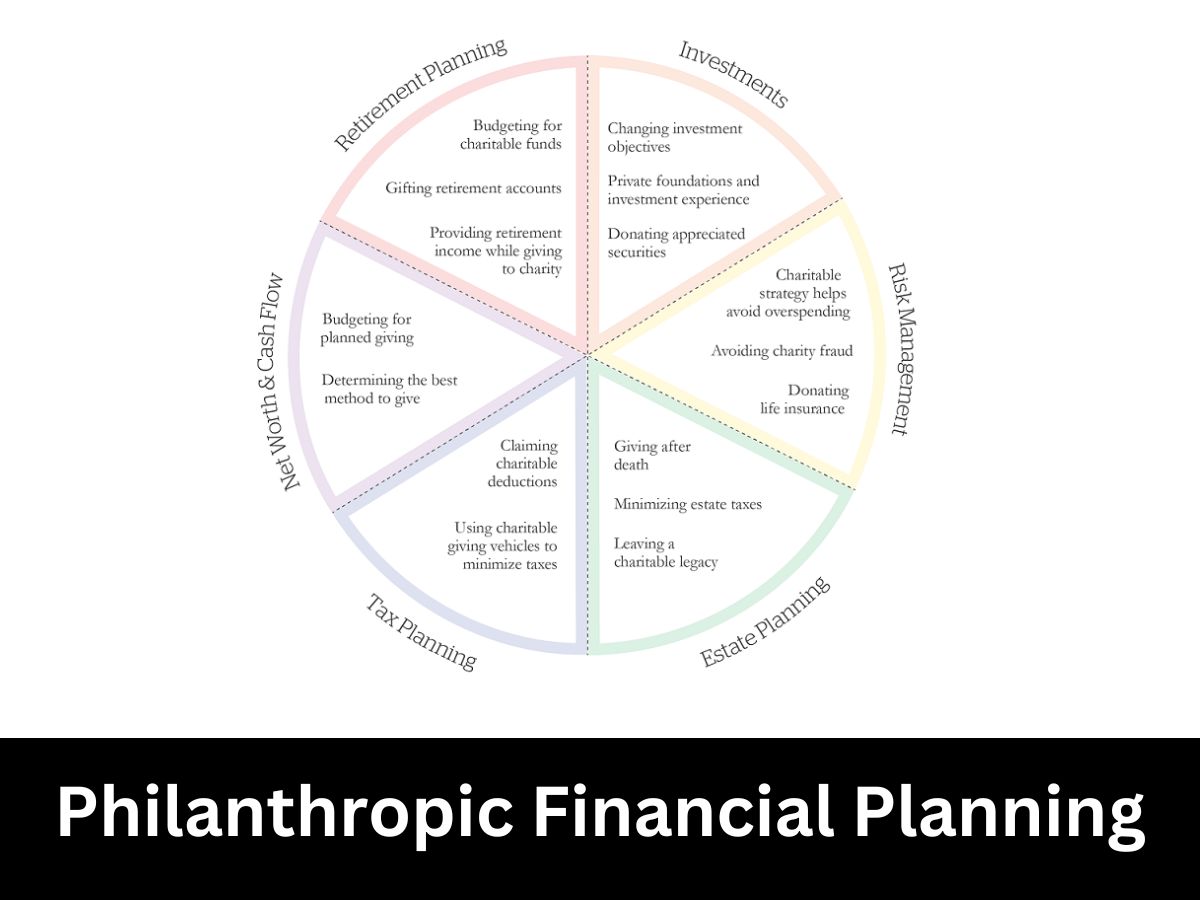Cno Philanthropic Financial Planning helps individuals and organizations manage charitable giving effectively. It maximizes impact while ensuring financial stability.
Cno Philanthropic Financial Planning offers expert guidance for those looking to integrate philanthropy into their financial strategies. This service helps clients develop tailored plans that align with their values and financial goals. By focusing on sustainable giving, Cno ensures that donations make a lasting difference.
Their team of professionals provides comprehensive advice on tax benefits, donation strategies, and charitable trusts. Cno also assists organizations in creating impactful community programs. This holistic approach benefits both donors and recipients, fostering a culture of generosity and financial health. With Cno’s expertise, clients can navigate the complexities of philanthropic financial planning with ease and confidence.

Credit: stockupdates.co.uk
Introduction To Philanthropic Financial Planning
Philanthropic financial planning helps individuals give back to society. This type of planning combines personal finance and charitable goals. It ensures that donations create a lasting impact. This process involves thoughtful strategies and careful execution.

Concept And Importance
Philanthropic financial planning focuses on aligning financial goals with charitable intentions. This type of planning helps maximize the impact of donations. It also provides tax benefits to donors.
Key elements of philanthropic financial planning include:
- Identifying charitable causes
- Setting donation goals
- Choosing the right giving vehicles
Giving vehicles can be:
- Trusts
- Foundations
- Donor-advised funds
Proper planning ensures funds are used efficiently. It also helps in creating a sustainable impact.
Historical Background
Philanthropic financial planning has deep historical roots. Ancient societies practiced forms of charity. Wealthy individuals and families donated to support communities.
During the Middle Ages, churches played a key role in charitable giving. They managed funds and distributed resources to the needy.
In the 19th century, industrialists like Andrew Carnegie and John D. Rockefeller formalized philanthropy. They established foundations to support various causes.
Today, philanthropic financial planning is more structured. It uses modern financial tools and strategies. This ensures a more significant and lasting impact.
Core Principles Of Philanthropic Financial Planning
Philanthropic financial planning combines financial strategies with charitable goals. It ensures that donations make a lasting difference. By understanding the core principles, you can make informed decisions. This approach helps in achieving both financial stability and social impact.
Strategic Giving
Strategic giving involves planning donations to achieve specific goals. It’s about making sure that each dollar has the highest impact. This requires understanding the needs of the community. You must also know the strengths of the charitable organizations.
- Set clear, achievable goals.
- Research potential charities.
- Analyze how funds are used.
A strategic approach helps in tracking progress. It ensures that your contributions lead to meaningful changes.
Sustainable Impact
Sustainable impact means creating lasting positive changes. This is more than just giving money. It’s about investing in projects that will continue to benefit the community over time.
- Focus on long-term projects.
- Partner with reliable organizations.
- Monitor the outcomes regularly.
Creating a sustainable impact requires ongoing commitment. It ensures that your donations do more than just provide temporary relief.
| Principle | Description |
|---|---|
| Strategic Giving | Planning donations to achieve specific goals |
| Sustainable Impact | Creating lasting positive changes |
By following these core principles, you can make a real difference. Your contributions will be more effective and impactful.
Benefits Of Philanthropic Financial Planning
Philanthropic financial planning is a strategic way to manage your finances. It not only helps you donate wisely but also offers numerous benefits. Let’s explore the key advantages of engaging in philanthropic financial planning.
Tax Advantages
One of the most significant benefits is the tax advantages. Donating to charities can reduce your taxable income. You can claim deductions on your tax return. This means more money stays in your pocket.
Here’s a quick overview of tax benefits:
| Type of Donation | Tax Deduction |
|---|---|
| Cash Donations | Up to 60% of AGI |
| Property Donations | Fair Market Value |
Community Development
Philanthropic financial planning fosters community development. Your contributions support local projects and initiatives. This builds stronger, healthier communities.
Benefits to the community include:
- Improved infrastructure
- Better education systems
- Access to healthcare
Supporting your community can create a positive cycle of growth. People thrive, businesses grow, and the overall quality of life improves.
Challenges In Philanthropic Financial Planning
Philanthropic financial planning involves unique challenges. These challenges can affect the success of philanthropic efforts. Understanding these obstacles can help you plan better and achieve your goals.
Regulatory Hurdles
Regulatory hurdles can complicate philanthropic financial planning. Each country has its own rules and regulations. These rules can differ widely. Compliance with these regulations is essential. Failure to do so can result in fines and penalties.
- Different tax laws in different countries
- Legal requirements for charitable donations
- Documentation and reporting standards
Organizations must stay updated on the laws. This ensures that they remain compliant. It also helps in avoiding legal issues.
Measurement Of Impact
Measuring the impact of philanthropic activities is challenging. It is vital to know if the funds are making a difference. This requires proper tools and methods.
| Challenges | Details |
|---|---|
| Defining Metrics | Setting clear and measurable goals |
| Data Collection | Gathering accurate and relevant data |
| Analysis | Interpreting the data correctly |
Proper measurement helps in improving future efforts. It ensures that the resources are used effectively. This can also help in gaining more support and funding.
Steps To Effective Philanthropic Financial Planning
Philanthropic financial planning helps you make a big impact. This involves planning your donations to achieve the best results. Follow these steps to ensure your giving is effective and meaningful.
Setting Goals
First, set clear goals for your philanthropy. These goals guide your giving and measure your impact. Ask yourself:
- What do I want to achieve?
- Who do I want to help?
- How much can I give?
Make your goals specific and measurable. For example, aim to support 10 students with scholarships this year. Clear goals will help you track your progress and stay motivated.
Choosing Causes
Next, choose the causes you care about. Think about the issues that matter most to you. Here are some questions to consider:
- What problems do I want to solve?
- Which communities do I want to support?
- What kind of change do I wish to see?
Research different organizations and their missions. Ensure they align with your values. Look for groups with proven results and transparent operations.
| Cause | Impact |
|---|---|
| Education | Improves literacy, empowers youth |
| Healthcare | Saves lives, promotes wellness |
| Environment | Protects nature, fights climate change |
Choosing the right causes ensures your donations make a real difference. Focus on areas where you can see tangible results.

Innovative Approaches
Cno Philanthropic Financial Planning is evolving. New methods are making giving more effective. These innovative approaches help maximize the impact of your contributions.
Impact Investing
Impact investing is a powerful way to use your money. It allows you to support causes you care about. You invest in companies that create social and environmental benefits.
| Benefits | Examples |
|---|---|
| Supports social good | Renewable energy companies |
| Can provide financial returns | Affordable housing projects |
By choosing impact investments, you align your financial goals with your values. This approach helps create a better world.
Donor-advised Funds
Donor-Advised Funds (DAFs) offer flexibility in your giving. You can donate to a DAF and then recommend grants to your favorite charities. This allows you to plan your donations over time.
- Immediate tax benefits
- Grow donations through investments
- Give when the time is right
DAFs are easy to set up. They provide an efficient way to manage charitable giving. With DAFs, you can make a lasting impact on the causes you support.
Case Studies
Case studies offer real-world examples of how Cno Philanthropic Financial Planning has helped clients achieve their goals. By examining these scenarios, you can gain insights into successful strategies and common challenges.
Successful Transformations
Many clients have experienced significant improvements through Cno Philanthropic Financial Planning. Here are a few examples:
| Client | Initial Situation | Outcome |
|---|---|---|
| Non-Profit A | Struggling with budget deficits | Achieved financial stability in 12 months |
| Charity B | Limited funding for programs | Increased donations by 50% |
| Foundation C | Unclear financial goals | Set and met clear objectives |
Lessons Learned
Each case study provides valuable lessons:
- Non-Profit A: Consistent budgeting and expense tracking are crucial.
- Charity B: Engaging donors through regular updates boosts donations.
- Foundation C: Setting clear financial goals leads to success.
These lessons highlight the importance of strategic planning and donor engagement. By applying these principles, other organizations can also achieve their financial goals.

Credit: techwires.co.uk
Future Trends In Philanthropic Financial Planning
The landscape of philanthropic financial planning is changing fast. Innovations in technology and global partnerships are shaping the future. These trends offer new opportunities for giving and managing funds effectively.
Technology Integration
Technology integration is transforming philanthropic financial planning. Various tools now help in managing and tracking donations. Blockchain technology ensures transparency and security in transactions.
Below is a table showcasing the key technologies impacting philanthropic financial planning:
| Technology | Benefit |
|---|---|
| Blockchain | Enhanced transparency and security |
| AI and Machine Learning | Better donor targeting and fund allocation |
| Cloud Computing | Efficient data management and accessibility |
Artificial intelligence (AI) helps in analyzing data to identify potential donors. Machine learning algorithms can predict donation patterns and optimize fund allocation. Cloud computing offers scalable solutions for data storage and management.
Global Collaborations
Global collaborations are becoming more common in philanthropic financial planning. Organizations from different parts of the world are coming together. This collaboration helps in addressing global challenges more effectively.
Here are some benefits of global collaborations:
- Pooling of resources for greater impact
- Sharing of knowledge and best practices
- Increased reach and influence
International partnerships enable the sharing of best practices. They also help in mobilizing resources to tackle issues like poverty, education, and health. Cross-border initiatives ensure that aid reaches those who need it most.
Frequently Asked Questions
What Is Philanthropic Financial Planning?
Philanthropic financial planning involves managing your finances to support charitable causes. It includes strategies like donations, grants, and endowments. This method helps in maximizing both financial growth and social impact.
How Does Cno Support Philanthropy?
Cno provides tailored financial plans for charitable giving. They offer advice on tax-efficient donations and setting up foundations. Their services ensure your philanthropic goals align with your financial objectives.
Why Integrate Philanthropy In Financial Planning?
Integrating philanthropy in financial planning maximizes impact. It allows you to support causes while achieving financial goals. This approach also offers potential tax benefits and personal fulfillment.
Can Philanthropy Improve Financial Outcomes?
Yes, philanthropy can improve financial outcomes. Strategic charitable donations can provide tax advantages. Moreover, aligning your finances with your values can lead to greater personal satisfaction and long-term financial success.
Conclusion
Philanthropic financial planning can significantly impact communities and create lasting positive change. By integrating financial strategies with philanthropy, individuals can achieve both personal and societal goals. Start planning today to make a meaningful difference while securing your financial future. Embrace the power of giving and see the benefits unfold.